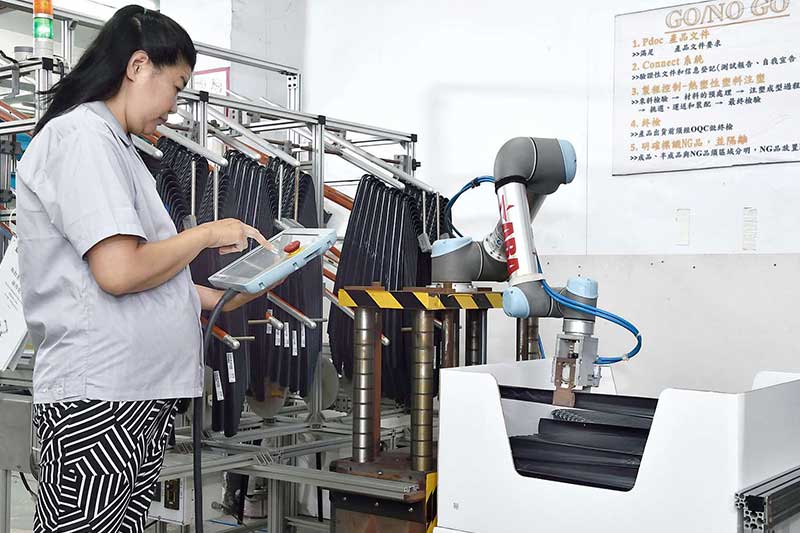The use of robotics in manufacturing dates back to the 1960s. Since the invention of the first industrial robot, they have been used for different processes in manufacturing, including painting, welding, machine tending, and even assembly.
Advancements in technology have brought rise to collaborative robots. These are new-age upgrades from traditional industrial robots with the ability to work safely alongside humans, which is their main selling point. Compared to industrial robots, collaborative robots are faster and work with better accuracy than human workers. This has bought rise to the fast adoption of collaborative robots in manufacturing floors where they work alongside humans, taking on repetitive, dangerous, and difficult tasks.
Production line robots also referred to as assembly robots, are some of the most used collaborative robots in the market. An assembly robot comes in handy in manufacturing environments that require speed, precisions, and high cleanliness levels, like the pharmaceutical industry.
4 ways collaborative robots are used in the manufacturing industry.
Assembly
Assembling parts in the creation of complete products can be a highly repetitive and tedious task for human workers. When done by human workers, assembled products are prone to show defects since there is a higher margin of error, which leads to low-quality products. Presenting a low-quality product to the market can negatively affect a company’s reputation and affect the profit targets.
Using collaborative robots in assembly processes is ideal for ensuring you have an accurate assembling process while making it less labor-intensive. All parts are assembled to the highest finishing standards, which can boost sales. Using collaborative robots for assembly in manufacturing can also reduce human injury.
Picking, packing, and palletizing
Picking, packing, and palletizing processes are some of the processes that call for high accuracy in manufacturing. These are also expensive, labor-intensive, and mind-numbing tasks to human employees. Also worth noting is that human workers are prone to errors when handling machines for picking, packing, and palletizing processes, which affects the quality of the finished products.
When collaborative robots are used for picking, packing, and palletizing, a manufacturing company can enhance quality control, which is sometimes difficult with human workers. Collaborative robots have the ability to work alongside humans safely to ease the workload while maintaining service delivery to the highest standards.
Welding
Welding and soldering are difficult tasks done by humans in manufacturing companies that have not adopted automation. These labor-intensive processes call for longer resting time, which calls for a lot of downtime as employees take their breaks from work. This results in prolonged deadlines since humans take a lot of time to complete the work.
The best way companies can avoid downtime is by employing cobots for strenuous and repetitive processes like welding.
Material handling
Material handling contributes to a large part of the economy of any country. This is because the process involves moving materials around the manufacturing plant or factory floors, which is time-consuming and tedious for human workers.
Manufacturers need to automate the material handling process to meet the consumer’s expectations.
Collaborative robots can be used for moving materials within a production floor. They also can safely handle potentially harmful raw materials, reducing human exposure.
Industries employing the use of assembly robots
As robotics automation continues to advance, robotics has grown to become influential players in manufacturing on a global scale. Here are some of the industries that have adopted the use of robotics to improve productivity, efficiency, and precision.
The automotive industry
The automotive industry has grown in leaps and bounds since the invention of automation. For more than 50 years, robotics are used in the assembly line process and product testing.
Many car manufacturing facilities employ the use of collaborative robots to allow human employees to work alongside these robots to speed up production. Because robots are flexible and do not need rest, they are programmed to perform monotonous tasks for speed and accuracy.
Medicine
The medical field is one of the industries that has greatly benefited from advanced robotic automation. Collaborative robots are now being used as helpers for surgeons in performing surgeries that require at most precision.
In one survey, a semi-autonomous surgical robot sowed better performance than a human surgeon. The robot performed the procedure with better precision and less damage to the surrounding tissue. The accuracy of robots guarantees higher success rates in delicate medical procedures.
Manufacturing of electronics
To keep up with the constant demand for better smartphones, flat-screen TVs, and other electronics, electronic manufacturers have found a way to boost production speed without compromising quality. This is only possible with the help of automation technology.
Collaborative manufacturing robots can increase production on factory floors without compromising on the quality of the part or taking up valuable space. The electronics manufacturing industry specifically employs cobots because of their ability to handle different tasks and safely work alongside human employees.
Food Manufacturing
The use of robots in food and beverage manufacturing helps improve the quality of a product by detecting issues in the production process. This is achieved using processing hardware and software algorithms as well as machine vision sensors and cameras.
The use of robotics in food manufacturing delivers consistent food products quality and improved safety for consumers.
Agriculture
The agriculture sector has been using robotics automation to boost productivity and lower production costs. Thanks to robotics sensor technology, farmers can keep an eye on pests and plant diseases that affect crop yields negatively. Automated robotic systems are used to run operations like spraying, pruning, and weeding for better yields.
Conclusion
Manufacturing robots can offer numerous benefits to your manufacturing company. While smaller manufacturing businesses assume that robotics automation is expensive, the ROI is worth the investment.
Even though the initial cost is high, the benefits robotics bring can save manufacturers thousands of dollars in improved productivity and reduced operational costs.
Collaborative robots offer greater consistency and better quality, especially for repetitive tasks. Their behavior is predictable, and their movements are precise. This makes them ideal for producing high-quality products with greater consistency and minimal variation compared to their human counterparts.
The best part is that robots do not need breaks and can work without shift changes or other interruptions. Once a cobot has been programmed and trained for a job, it speeds production cycles and creates more efficient production processes, which translates to higher profits.

“Certified tv guru. Reader. Professional writer. Avid introvert. Extreme pop culture buff.”






More Stories
KickRender enables faster 3D rendering thanks to AI technology
Images and audio become talking video
Blockchain Technology – CVJ.CH Academy